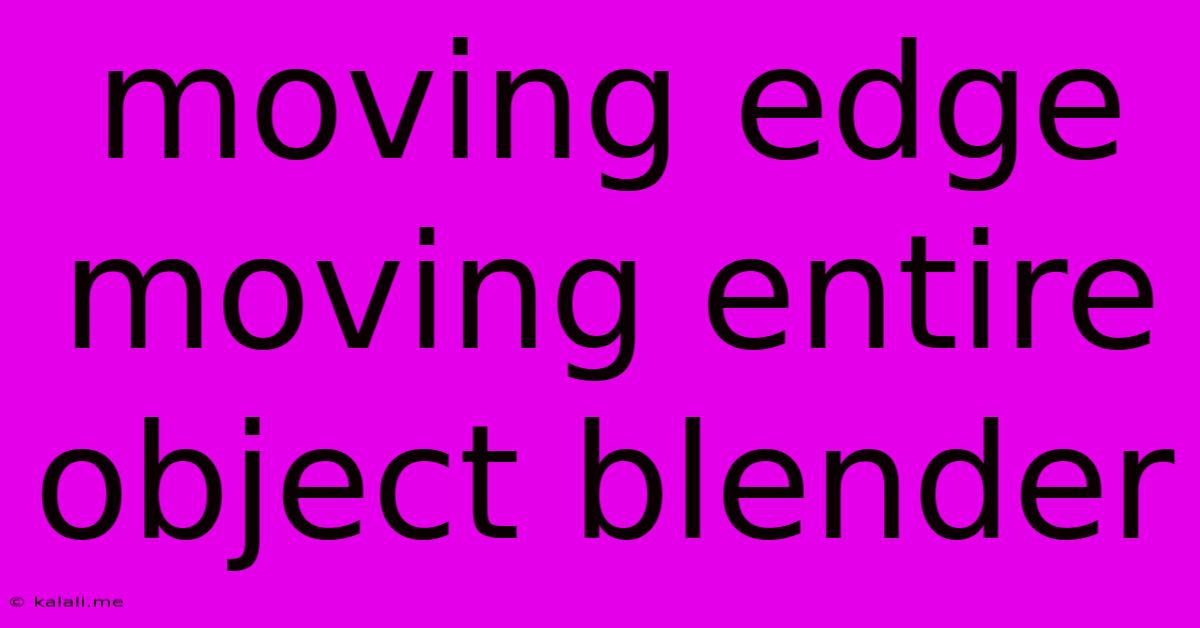Moving Edge Moving Entire Object Blender
Kalali
May 26, 2025 · 3 min read

Table of Contents
Moving Edges vs. Moving Entire Objects in Blender: A Comprehensive Guide
This article will explore the different methods for moving objects in Blender, focusing on the distinction between manipulating edges and moving entire objects. We'll cover the practical applications of each technique and when one method is preferable over the other. Mastering these techniques is crucial for efficient and precise modeling in Blender.
Why Understanding Edge and Object Manipulation Matters
Blender offers a powerful and flexible modeling workflow. Understanding how to effectively manipulate edges and entire objects is key to creating clean, efficient, and accurate 3D models. Choosing the right method depends on your specific modeling goals – whether you're creating precise shapes or making larger-scale adjustments. Incorrect selection can lead to unexpected results and frustration.
Method 1: Moving Entire Objects
This is the simplest method, ideal for repositioning, scaling, and rotating entire models without affecting their individual components.
Steps:
- Selection: In Object Mode, select the object you wish to move using either the right-click method or by using the A key to select all objects, then deselecting the unwanted ones.
- Transformation: Use the Grab tool (G) to move the object freely in 3D space. You can constrain movement to specific axes (X, Y, or Z) by pressing the corresponding key after pressing G.
- Precision: Use numerical input to precisely position your object. After pressing G, type in the desired coordinates to place the object exactly where you need it. This is especially helpful for aligning objects accurately.
- Transformations Panel: The properties panel displays precise numerical values for location, rotation, and scale. These values can be manually adjusted for fine control.
When to Use This Method:
- Repositioning objects in a scene: Moving entire models within a scene is best handled through object manipulation.
- Large-scale adjustments: For broad changes to an object's position, using the object mode is more efficient.
- Maintaining object integrity: This method preserves the object's original shape and structure.
Method 2: Moving Edges (Edge Selection and Manipulation)
This method is more nuanced and provides more granular control, particularly useful for precise sculpting, modeling, and modifying the shape of individual parts of an object.
Steps:
- Switching to Edit Mode: Enter Edit Mode (Tab) to access the object's individual vertices, edges, and faces.
- Edge Selection: Select the specific edges you wish to move. Use the Alt + RMB to select linked edges. You can also box-select (B) or lasso-select (C) multiple edges.
- Transformation: Use the Grab tool (G) to move the selected edges. Again, you can constrain movement to specific axes.
- Proportional Editing: This is a powerful tool for influencing surrounding geometry. Enable proportional editing (O) and adjust the falloff type and radius to control the influence of your edge movements on nearby geometry. This allows for organic and smooth shape adjustments.
- Snapping: Use snapping tools to align edges precisely with other elements in your model. This ensures accuracy and consistency.
When to Use This Method:
- Precise shaping and sculpting: Edge manipulation provides fine-grained control over the form of your object.
- Creating curves and bends: It's ideal for manipulating curves and creating intricate shapes.
- Modifying individual sections of an object: Allows for focused changes to specific areas of your model without affecting the rest.
- Extrude and Inset Operations: Moving edges after using extrusion or inset tools enables the creation of complex shapes.
Comparing the Two Methods: A Summary
| Feature | Moving Entire Objects | Moving Edges |
|---|---|---|
| Level of Control | Low | High |
| Speed | Fast | Slower |
| Precision | Lower | Higher |
| Use Cases | Repositioning, scaling | Shaping, sculpting, detailing |
By understanding the strengths and weaknesses of each method, you can significantly improve your workflow in Blender and create more sophisticated 3D models. Experiment with both techniques to find the best approach for your specific modeling needs. Remember to practice regularly to master these essential skills and unlock the full potential of Blender's modeling tools.
Latest Posts
Latest Posts
-
How Do You Get Rid Of Moths
May 27, 2025
-
Words That Start With G H
May 27, 2025
-
How Did Wolverine Get His Adamantium Back
May 27, 2025
-
How To Say My Love In Spanish
May 27, 2025
-
Error Unexpected Method Appcast Called On Cask Adoptopenjdk11
May 27, 2025
Related Post
Thank you for visiting our website which covers about Moving Edge Moving Entire Object Blender . We hope the information provided has been useful to you. Feel free to contact us if you have any questions or need further assistance. See you next time and don't miss to bookmark.